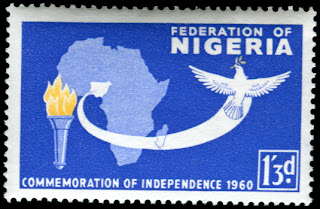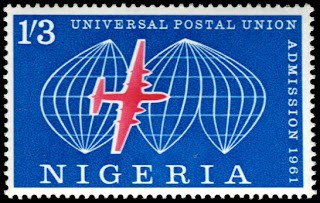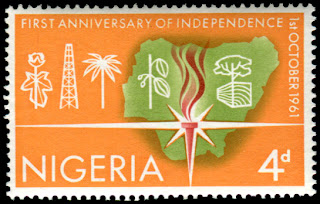Commemorative Issues of 1956-1961
At the end of my last post, I stated that I would show you some more of the commemorative issues of the 1960's. There are so many issues from this period that I had a hard time deciding which ones to show you. In the end though, I thought it best to go back to the early issues that came out just before Independence, the Independence issue itself, and the first issues after Independence.
These issues give a real sense of how much anticipation and hope there was around the time of Independence. It was the culmination of a long and patient struggle that many prominent Nigerians were engaged in. The stamp designs show the collective pride that most Nigerians felt, once they had accomplished their goal.
The issues were printed by two firms: Waterlow and Sons, who produced the engraved pre-Independence issues and the Independence issue itself, and Harrison and Sons, who printed all of the issues after Independence.
The first of these is the Royal Visit Issue, which appeared on January 28, 1956 to commemorate Queen Elizabeth's Visit to Africa:


These issues give a real sense of how much anticipation and hope there was around the time of Independence. It was the culmination of a long and patient struggle that many prominent Nigerians were engaged in. The stamp designs show the collective pride that most Nigerians felt, once they had accomplished their goal.
The issues were printed by two firms: Waterlow and Sons, who produced the engraved pre-Independence issues and the Independence issue itself, and Harrison and Sons, who printed all of the issues after Independence.
The first of these is the Royal Visit Issue, which appeared on January 28, 1956 to commemorate Queen Elizabeth's Visit to Africa:
The issue consisted of the regular 2d definitive, overprinted in black, in two lines "Royal Visit 1956". Presumably, there was not sufficient time to produce an entirely original design for this stamp, although what is interesting is that an entirely new printing was used for the issue, made from plate 5, which is not found unoverprinted. A rare inverted overprint exists, and is eagerly sought after by specialists. I have yet to see one.
On December 1, 1958, Waterlow printed a centennial commemorative stamp for Victoria, which was settled in 1858:

Victoria is now part of Cameroun and is now known by the name Limbe. It is one of two seaports that formed part of the Southern Cameroons, the other one being Tikko. The southern Cameroons became part of Cameroun after a national Plebiscite that was held in 1961.
The next issue, also printed by Waterlow, appeared on March 14, 1959 and marked the attainment of Self Government for the Northern Administrative Region, which has held firm to this day. Indeed many of the current political problems in Nigeria today stem from very fundamental religious and philosophical differences between the Hausa and Fulani peoples of the North, and the Yoruba and Igbo peoples of the South. The stamps issued were a 3d value depicting Lugard Hall, and a Kano Mosque as follows:

Nigeria obtained its independence on October 1, 1960. In my opinion, the set of stamps that was released to mark this very monumental occasion was very lackluster. Indeed, when one looks at the many rejected designs that were produced for this issue, it is very difficult to understand why the designs that were issued were chosen. Be that as it may, it is the issue that was released, and a certain amount of respect must be accorded to it, I think. The issue was produced by Waterlow and was one of the few issues that they printed using the photogravure process. The stamps in the set included a 1d value to pay the local drop rate, a 6d for local registered mail, a 3d for surface mail to the UK and a 1/3d value for foreign airmail.
1d Federal Legislature - designed by L.J. Whittington
3d Nigerian Paddling Canoe - designed by R. Crawford
6d Federal Supreme Court - designed by R.D Baxter
1/3d Dove, Torch and Map of Africa, showing Nigeria - Designed by J. White
As you can see from the designers names, all the stamps of this issue were designed by Brits, which is surprising, given that one would have expected submissions by many Nigerians. But then again, this may have been the reason for their selection: one last attempt to have the stamps designed by British designers.
Nigeria was very late in joining the Universal Postal Union. Many collectors would be surprised to learn that Nigeria did not join until 1961, given that many of the colours of the definitives prior to this conformed to the UPU standard colours. This was the first commemorative issue that was printed by Harrison and Sons, and appeared on July 25, 1961. The entire set was designed by the prominent British stamp designer, M. Goaman. The set consisted of a 1d value for local drop letters, a 3d value for foreign surface mail and registration, a 1/3d for foreign single weight airmail and a 2/6d value for the double airmail rate:
1d Globe and Diesel Electric Locomotive
3d Globe and Mail Van
1/3d Globe and Bristol 175 Britannia Aircraft
2/6d Globe and Ocean Liner
On October 1, 1961, Nigeria celebrated its first anniversary of independence. On this day a set of stamps appeared to commemorate the anniversary. In fact, for the next seven years, Nigeria released a set of stamps to commemorate the anniversary, although from 1963 onwards, the anniversary was the attainment of Republic status, rather than just independence. Fittingly, this set was designed by a number of Nigerian, British and Israeli stamp desingers and was printed by Harrison & Sons. The designs included a 3d for foreign surface mail, a 6d for local registered mail, and a 1/3d and 2/6 for the foreign single and double weight airmail rates.
3d Coat of Arms - Designed by S. Bodo
4d Natural Resources, Torch and Map - Designed by R. Hopeman
6d Nigerian Eagle - Designed by C. Adesina
1/3d Eagles Flying as Nigerian Flag Formation - Designed by M. Shamir
2/6d Nigerian couple, Local Legislature and Nigerian Flag -Designed by B. Enweonwu
There you have it, the first commemorative issues both before, and immediately after Nigerian Independence. My next post is going to go back in time and look at the earlier Colonial definitive issues prior to 1935.

















Comments
Post a Comment